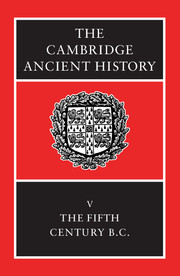Crossref Citations
This Book has been
cited by the following publications. This list is generated based on data provided by Crossref.
Salmon, John
1992.
Greek History.
Greece and Rome,
Vol. 39,
Issue. 2,
p.
235.
Andrews, James A.
1994.
Cleon's Ethopoetics.
The Classical Quarterly,
Vol. 44,
Issue. 1,
p.
26.
Raaflaub, Kurt A.
2000.
The Cambridge History of Greek and Roman Political Thought.
p.
23.
Rowe, Christopher
Schofield, Malcolm
Harrison, Simon
and
Lane, Melissa
2000.
The Cambridge History of Greek and Roman Political Thought.
Cartledge, Paul
2000.
The Cambridge History of Greek and Roman Political Thought.
p.
7.
Taylor, C. C. W.
2000.
The Cambridge History of Greek and Roman Political Thought.
p.
122.
Winton, Richard
2000.
The Cambridge History of Greek and Roman Political Thought.
p.
89.
Ober, Josiah
2000.
The Cambridge History of Greek and Roman Political Thought.
p.
130.
Andrews, James A.
2000.
Cleon's hidden appeals (Thucydides 3.37–40).
The Classical Quarterly,
Vol. 50,
Issue. 1,
p.
45.
Goldhill, Simon
2000.
The Cambridge History of Greek and Roman Political Thought.
p.
60.
Gray, V. J.
2000.
The Cambridge History of Greek and Roman Political Thought.
p.
142.
Dyson, Michael
2002.
Thucydides and the Sandbar at Pylos.
Antichthon,
Vol. 36,
Issue. ,
p.
19.
Ober, Josiah
and
Samons, Loren J.
2004.
Ancient Greek Democracy.
p.
76.
Morris, Ian Peter
2005.
The Athenian Empire (478-404 BC).
SSRN Electronic Journal,
Scheidel, Walter
Morris, Ian
and
Saller, Richard P.
2007.
The Cambridge Economic History of the Greco-Roman World.
Scodel, Ruth
2012.
A Companion to Sophocles.
p.
25.
Keim, Benjamin
2012.
The Encyclopedia of Ancient History.
2013.
The Encyclopedia of Greek Tragedy.
p.
159.
Hawthorn, Geoffrey
2014.
A Handbook to the Reception of Thucydides.
p.
579.
Revermann, Martin
2014.
The Cambridge Companion to Greek Comedy.



